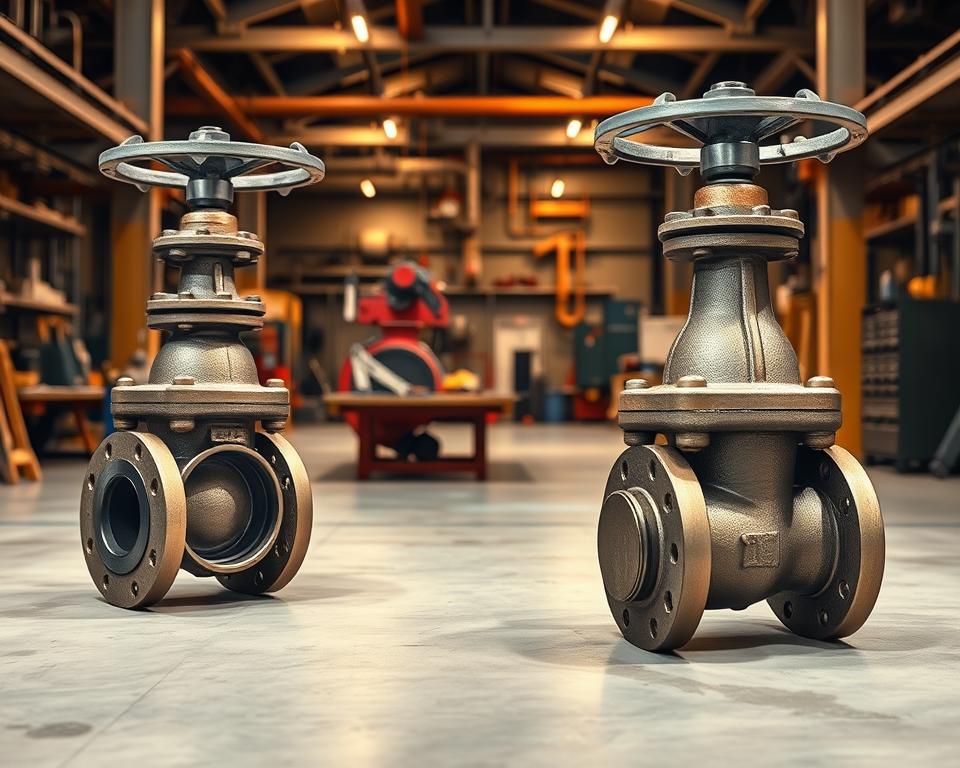Cast Iron Gate Valves: Rugged Plant Flow Control
Surprising fact: More than 60% of municipal distribution lines continue to use conventional isolation gear for reliable isolation when incidents occur.
We offer a workhorse line of Cast Iron Gate Valve Manufacturer built for long life in industrial, commercial, and municipal use across the United States. Each unit pairs a robust body-and-bonnet assembly with a well-proven gate design to fight abrasion and reduce corrosion under changing pressure and temperature cycles.
The unobstructed gate cuts flow restriction in the open position, helping systems move water and compatible media with minimal headloss. Designers and maintenance teams prefer the simple serviceability, common connection options, and easy-to-source parts that streamline selection and repairs.
This range includes a variety of series and class ratings to match common duty ranges, end connections, and operator preferences. You get predictable sealing, steady operating torque, and budget-friendly ownership focused on uptime and low life-cycle cost.
Key Takeaways
- Built for durable shutoff and reliable flow control in varied environments.
- Sturdy construction resists wear, corrosion, and mechanical stress.
- Straight-through design delivers minimal resistance and less pressure loss.
- Offered in multiple series and class ratings to match common specifications.
- Service-friendly design, common parts, and predictable sealing improve uptime.
Precise Flow Control Using Cast Iron Gate Valves
Engineered shutoff units with accurate wedges and machined seats offer consistent performance across commissioning, operation, and shutdown cycles. Stout iron bodies and tight-sealing seats enable consistent sealing. That consistency supports safe isolation and minimizes unplanned downtime.
Smooth-operating feel lower handwheel effort and enable confident wedge positioning. Straightforward stems and common accessories simplify adapting a valve to manual or automated controls. Less effort streamlines routine checks and repairs.

Stem Types and Performance
| Aspect | Rising Stem | Non-Rising Stem |
|---|---|---|
| Open/close visibility | High — easy visual readout | Low — minimal external cue |
| Overhead clearance | Requires vertical space | Better for tight or buried service |
| Inspection | Accessible for checks | Low profile with similar longevity |
Fully open, the unobstructed passage delivers minimal headloss and smooth throughput. Tight shutoff limits leakage risk and helps keep target pressure for downstream equipment. In combination, these traits trim ownership cost and boost system uptime across common commercial and light industrial applications.
Design Choices and Options: Cast Iron Gate Valves
Detailed design choices—body alloy, stem type, and flange standard—dictate fit and performance as well as serviceability.
Body and bonnet construction
The body and bonnet use cast iron for rigidity and resistance to vibration. Machined guides maintain gate alignment for reliable sealing.
Rising stem vs non-rising stem
A rising stem provides a clear visual position indicator and allows easy inspection but requires overhead space. A non-rising stem saves overhead space and keeps threads protected inside the bonnet.
Both stem designs are compatible with standard handwheels and can be actuator-ready or external indicator posts when automation is required.
Class 125 performance guidance
ASME Class 125 is typical for water and general service within moderate temps. Check published pressure-temperature limits to verify suitability for the intended operating envelope.
Flange Details and Dimensions
| Parameter | Standard | Notes |
|---|---|---|
| Bolt circle | ASME/ANSI pattern | Compatible with typical piping |
| Face-to-face | Per industry series | See datasheet for dimensions |
| Bolts | Specified grade/torque | Select gasket to suit service |
- Range: from small diameters up to large mains with varied series and trim choices for wear resistance and ease of service.
- Trim choices and packing: seat and wedge materials optimize tight shutoff and longevity; improved packing with bonnet gaskets bolster stem sealing.
- Install tips: verify F2F length, bolt patterns, and torque values ahead of install.
Applications, Codes, and Integration
Applications for these Resilient Seated Gate Valve span municipal water mains, building risers, and pump-room isolation points where reliable shutoff is critical.
Water distribution and fire systems commonly apply these as sectional/control points. They provide visible status and strong shutoff for life-safety and utility networks.
Bi-Directional Service: Flow and Shutoff
The gate design allows shutoff in both flow direction when installed per manufacturer guidance. This adaptability simplifies layout decisions and works with redundant runs.
Maintenance, stem sealing, and bonnet integrity
Accessible bonnet bolts, guided gates, and serviceable packing make inspection and repacking faster. Correct packing compression maintains stem sealing through repeated cycles.
Indicators, OS&Y, and Orientation
External posts and OS&Y styles give visible open/closed status for inspections. Even with bi-directional capability, follow recommended direction orientation and clearance rules to ensure safe operation.
| Application | Primary Benefit | Spec Check |
|---|---|---|
| Water mains | Secure isolation | Verify Class 125 limits |
| Fire protection | Inspector-friendly indication | Use indicator or OS&Y option |
| Mechanical rooms | Service access | Confirm flange/F2F compatibility |
Conclusion
Choose proven shutoff equipment combining sturdy construction and predictable flow control.
These valves deliver durable isolation and reliable control across water and utility systems. Count on straightforward installation and service-friendly upkeep for reliable long-term service.
Notable specs include Class 125 rating, a robust body and bonnet, and engineered stem sealing to hold performance steady across commercial and plant environments.
Several series in common sizes, plus handwheel or actuator-ready options, simplify system matching. Visible position indication and low-friction stem travel improve daily operation and response under changing conditions.
The gate wedge and seat enables leak-tight closure and low pressure loss. Confirm sizes, end connections, and accessories at specification time to speed procurement and commissioning.
Choose valves manufactured to stringent standards. We can review class, sizes, and series to align selections with your operating and maintenance goals.